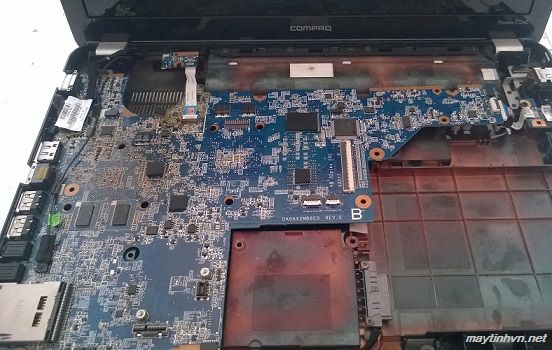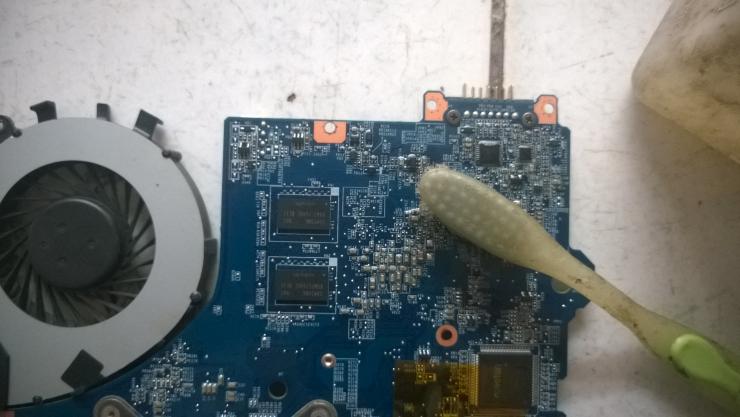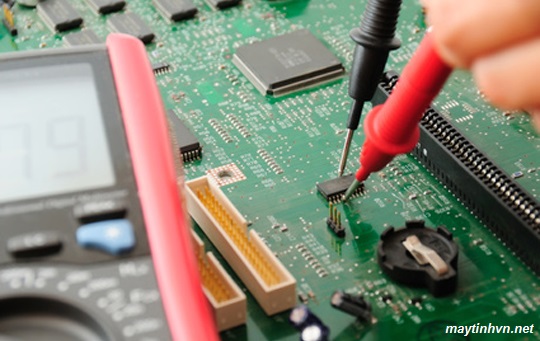When the laptop doesn’t power on, the screen doesn’t power on, or the computer boots up to windows (hears through the boot sound) but doesn’t show up… Those are common errors in Laptops, so what to do What happens when the laptop does not turn on? Here maytinhvn would like to share how I can fix it for everyone, anyone can handle it by themselves.
There are many cases when the laptop does not show up on the screen. I will split up different cases so you guys can see which case my device is having and handle it properly.
1. In case of complete voltage loss.
When you plug in the laptop’s adapter and turn on the power. But there is no sign, no power indicator light, power trigger light. We need to check the below steps:
+ See if the adapter has eaten power by looking at the power indicator on the adapter.
+ The adapter light is on, then we continue to check if the voltage at the output for the adapter is enough or not. By adjusting the Vol meter to the 50V scale, the black rod is placed outside the red rod inside and see how much the meter is on the needle. About 12v – 19v depending on how much voltage the laptop uses, can be seen on the charger or behind the body.
+ Check if the output voltage jack on the adapter is loose, often unplugging it, causing the power cord to break. To check, we can plug into the DC in jack on the Laptop. Plug and push in and at the same time turn on the power to see if it turns on.
+ If the above steps do not work, then we need to open the machine to check the power button, DC in jack is loose, if still, refer to the article: Laptop can’t power on.
2. In case the power indicator light is on, the machine lights up in Windows but does not show up.
When we turn on the power, see the power light, the hard drive light is on, press the Caps Lock key the light will light up and the machine will boot into windows (listen through the windows startup sound).
+ You need to connect a desktop LCD monitor via VGA, DVI or HDMI port to see if it shows up or not, depending on the type of machine that uses different external screen output buttons.
Press Fn and F4 keys at the same time on Laptop HP.
Fn and F5 key on Toshiba’s Laptop.
Fn and F7 key on an IBM laptop.
+ If the screen still does not output, it is necessary to check the VGA chip on the mainboard, there may be open pins or errors that make the screen not up.
+ If the desktop screen is output, it is necessary to check the screen, the cable connecting the mainboard to the screen, the high-voltage board, or the high-voltage cable. Usually this case is due to the high-voltage board, to replace the board you can refer to the article: Replace the multi-function high-voltage board.
3. In case of power on, the indicator light is on, but the picture is not displayed.
This case may be caused by mainboard error, short of devices, Ram error, BIOS error… You should check the order according to the steps below.
+ Remove the RAM cover under the body and check the RAM again. If the machine uses 2 RAM, we remove each stick one by one, clean the ram slot, RAM pins and plug it back in to see if it works. If not, try replacing 1 stick of RAM and see if it works well.
+ Remove the DVD drive, hard drive, PIN, WIFI card and try to power on. If the device boots, one of the above devices has been touched, making the device not display. You just need to attach them one by one to exclude.
+ The screen is short-circuited and also makes the laptop not turn on even though the desktop LCD screen does not turn on. You completely remove the cable connecting the LCD screen on the mainboard, then connect it to the external monitor to see if it comes up, if it does, then you know where the error is.

+ Finally, completely remove the mainboard from the case, leaving only the CPU, heatsink, RAM, power button, plug in the VGA cable to output to the external monitor. Then you plug in the power and try it, if the machine shows up, you need to check the built-in screen again, check if there is a mass touch with the shell… And if it doesn’t show up, the mainboard is faulty. Possible loss of secondary power, failure of CPU, Chipset, BIOS…
The above article is steps to check when the laptop does not power on for people who do not have much knowledge about hardware. And when we have fixed the familiar hardware, we can use the versatile source to check to know where the machine has been booted, which part is faulty, which will help shorten the time a lot. Thank you
.






